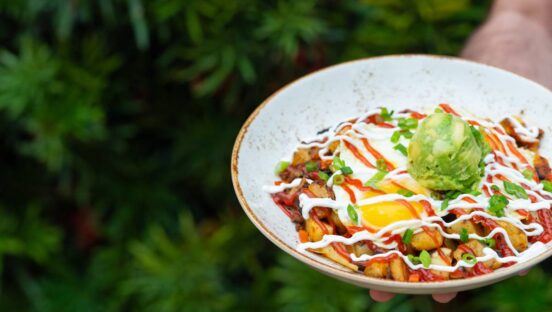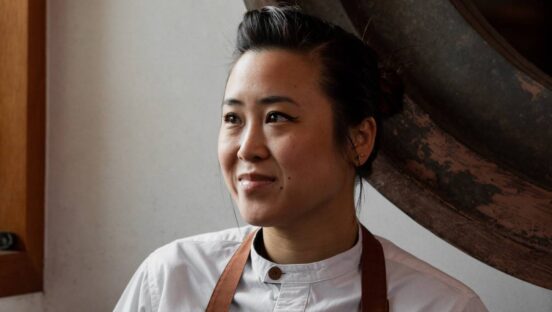


















This time three years ago, few could have fathomed what 2020 would bring—and that its effects would reverberate so far and wide. With any luck, the incoming year will be far less tumultuous, but even with Covid (mostly) in the rearview, a possible recession looms ahead. That’s why it’s just as critical now, as always, for operators to stay ahead of the curve and keep innovation top of mind, whether that’s updating in-house tech, expanding benefits for staff, or even pursuing new menu trends.
The future will always be uncertain, but with these 18 predictions from nine industry experts, restaurants can have a better view of what lies ahead, even if that landscape is, as always, subject to change.
Waste not
U.S. consumers have been gradually waking up to the reality that around a third of food is wasted, just as more restaurants are upping their efforts to cut such waste. The approaches they take run the gamut and can include smarter sourcing, more streamlined menus, utilizing ingredients in several dishes, and repurposing scraps.
San Francisco–based Flour + Water Hospitality Group aims to fully use every fruit and vegetable. The company will keep fruit stones, which often have some “meat” attached, to make vinegar; vegetables are cut for a more natural look, rather than diced, to eliminate leftovers; and some vegetable leftovers are pickled.
A shift to whole ingredients
Brands like Beyond Meat and Impossible Foods may have taken the U.S. by storm, but Maeve Webster, president of foodservice consultancy Menu Matters, says there’s growing concern around the processing methods and ingredients that go into these products. She expects consumer demand to veer toward more wholesome, recognizeable ingredients.
“Consumers want transparency and authenticity, by which I mean truthfulness. Those products have been highly forthright about what their products do for the environment and food system but have been opaque about their process and ingredients,” Webster says.
Although a number of full-service restaurants already make their own veggie burgers, she expects it to increase. “They can create something unique and differentiate themselves,” she adds.
Chaos cooking
The ’90s gave us fusion cuisine, and 2023 could give us “chaos cooking,” as Webster puts it. This mashup of foods gives free rein to chefs who want to illustrate their life experience, their culture, and their background via the dishes they create.
Per Webster, chaos cooking “is embracing the fact that we all have different [backgrounds], and it’s very relevant to tap into that to create something difficult to categorize. It’s a backlash against that authentic experience and not allowing people to be themselves and to experiment.”
For example, at Chauhan Ale & Masala in Nashville, Tennessee, owner Maneet Chauhan serves tandoori chicken poutine and lamb keema papadi nachos. In New York, forthcoming concept Sohogozo will reflect the roots of co-owners Alex Watanabe and Marcelo Baez, with Mexican-Japanese dishes like al pastor sushi rolls and shrimp teriyaki tacos.
In short, chaos cooking embraces the unexpected and uncharted. “Restaurants need to think about how to competitively differentiate themselves, [and this] allows them to offer really unique food based on the experience of the chefs,” Webster says.
Video-friendly food
Social media photos are no longer enough for effective digital engagement. Now, videos, especially on the platform TikTok, are driving traction online.
“[Consumers] don’t just want that static shot of a dish against a nice background; they want there to be some action,” says Mike Kostyo, associate director and trendologist at Datassential. “Cheese pulls, sauce drips, drink pours, tableside preparations, etc. are all key. If you notice a table taking videos of their food, lean into that. Even something as simple as a final dusting of cheese or a seasoning can go a long way toward making that video look great.”
Operators can also virtually invite guests into the back of house by filming chefs preparing a dish.
“We’re also starting to see more brands linking to videos of a dish being prepared through QR codes on menus, showcasing dishes on TikTok themselves, and even including more videos on menuboards and online menus,” Kostyo adds.
Nonalcoholic isn’t going anywhere
In 2021, sales of nonalcoholic beverages rose 33.2 percent, with nonalcoholic spirits exploding 113.4 percent, per NielsenIQ.
Zero-proof beverages are especially popular among younger generations. Restaurants can differentiate themselves with fun alcohol-free options, and these items have a high profit margin, says Sean Willard, a San Diego–based consultant and founder of Menu Engineers.
Restaurants have the option to craft their own cocktails or purchase bottled beverages that look like booze. For example, Black Ginger from niche CPG brand Tenneyson offers a high-end, zero-proof drink made with botanicals. Seattle-based Rock Grace boasts a line of three products that mimic champagne and wine.
“Restaurants want nondrinkers to feel comfortable among a group of people drinking alcohol,” Willard says. “It’s giving people permission to order them,” he says. “It’s also about putting the nonalcoholic offerings for guests to easily find and the price point will often be more profitable.”
Employees, first and foremost
Within foodservice and other consumer-facing sectors, employers are realizing they can’t create good experiences if their staff aren’t happy.
“Now more than ever, everyone is rethinking the employee experience across the board. What was once a hustle is now being scrutinized. It’s not just a money issue; it’s a quality of life issue,” says Joseph Szala, managing director of Atlanta-based restaurant branding firm Vigor. He adds that younger generations want to feel they’re making a difference, while maintaining a work-life balance.
“Companies are re-evaluating salaries and that trajectory upward,” he says. “They are investing in mental health and some of the standard benefits you’d find at a [regular] job.”
In addition to traditional benefits, keeping employees comfortable on the job will also become more important. Jeremy Kittelson, director of culinary design firm Ricca Design Studios, says restaurants need to provide simple amenities like break areas for staff, kitchens with good lighting and temperature control, and employee lockers.
“Everyone is battling for this resource, which is labor, so the nicer you can make that environment, the better,” he says.
Mental health matters
Depression, anxiety, and burnout are still huge issues for restaurant workers and Keith Sarasin, owner and executive chef at Indian fine-dining pop-up Aatma in New Hampshire, expects even more light to be shed on this issue in 2023.
Sarasin, who has battled depression, is heartened that the issue is gaining more attention. Across the country, more industry conferences are devoting sessions to topics surrounding suicide prevention, addiction, and anxiety.
People are also starting to speak out and create organizations specifically for people in the restaurant industry. Chef Jeffrey Schlissel is using social media to talk about mental health in the restaurant industry and has been open about his own suicide attempt at age 18.
“But there’s still a tremendous amount of work to do,” Sarasin says. “Until we break the stigma that vulnerability equals weakness, there can never be true dialogue. This isn’t about being broken; it’s about dealing with traumatic events [in a way] that doesn’t hurt people around us or affect our success.”
Sarasin would like to see well-known chefs joining the conversation, too. “People who are up-and-coming idolize big names, [and] if they were open and honest with their struggles, it would do a huge service to other people,” he says.
Modern steakhouses
The old stereotype of dark, moody steakhouses that cater mostly to male clientele is no more. Michael Parlapiano, managing director of foodservice consultancy The Culinary Edge, sees a number of modern steakhouses crop up, especially in major metropolitan areas.
“These new restaurants like STK are building these opulent dining rooms that cater to both men and women in the overall aesthetic, and it’s not just about tomahawk steaks and big cabernets but lots of different treatments and preparations,” he says.
Different cuisines, such as Middle Eastern and Japanese, are appearing on steakhouse menus alongside lighter fare such as seafood and vegetarian options. “There’s a desire for something new in a category that’s been a little bit stale,” Parlapiano adds.
Off-premises gets its own space
To drive off-premises orders without disrupting dine-in guests, restaurants are rethinking their spaces. More often than not, this approach involves designating a special area for takeout and delivery, whether adjacent to the host stand in the front or near the kitchen in the back. Some operators are even creating pickup windows—or side entrances—so consumers and third-party A
delivery drivers don’t even have to come inside.
The Moxy Hotel, which is soon to open in Atlanta, plans to sell meals from its taco concept directly from a walk-up window from the kitchen, which leads out onto a busy street.
And in October, James Beard-nominated chef Peter Chang opened a full-service concept, Chang-In, with a completely separate Chang-Out for pickup and third-party delivery orders. Located in D.C., the dual restaurant has separate entrances for its two businesses, which “are designed to complement one another and drive traffic between themselves depending on what experience the guests are looking for,” says Lydia Chang, the chef’s daughter and business partner.
Showpiece equipment
As more restaurants feature open or exhibition kitchens, operators will want to bring a wow factor to these functional spaces. Rick McCormack, founder of interior design firm Studio McCormack in Southern California, says that extending brand colors to kitchen equipment makes a strong statement and immediately differentiates a restaurant from its competitors.
Lisa Paige-Pretorius, associate and project manager with Cini-Little, a foodservice consulting firm in Maryland, says colorful open kitchens also communicate that the restaurant owner is on trend. “Generally, your whole cookline is stainless, but the front of it could be a sleek black, [which is] super contemporary.”
Adding pops of color can also help a restaurant coordinate the kitchen with the front of house. Furthermore, it allows operators to direct their guests’ attention to these presentation areas and away from the less desirable parts of the kitchen, Paige-Pretorius says.
Hybrid menus
While digital menus, accessed via QR codes, were the height of safety during the pandemic, not all diners want to look at their phones to order food.
Moving forward, Menu Engineers’ Willard predicts operators will use both print and digital menus, giving guests options and helping operators stay flexible with their offerings. If a restaurant does use a digital menu, he suggests it be properly formatted to promote sales of the right dishes.
And, he points out, guests’ attention spans can drop off when using their phones, so operators should give priority to the items they most want to sell.
The next third place
Another new year opportunity for restaurants is becoming the so-called third place consumers flock to (third after home and work).
Humans are still social creatures and are still going to look for places to meet with friends and family, go on dates, and celebrate occasions, points out Datassential’s Kostyo, especially with so many people working from home.
“Full-service restaurants should welcome consumers back and remind them why they love eating out and connecting. Creating cozy nooks, adding outdoor seating, introducing flexible seating for a wide range of party sizes, leaning into private dining rooms, will be key in 2023,” he says.
Kostyo expects the growth of eatertainment venues—offering everything from golf to pickleball and darts—to continue and suggests all restaurants could even add a few simple board games to their front of house.
Fine dining shines
Recent Datassential surveys show that 30 percent of consumers plan to increase their visits to fine dining venues in the future as they seek local ways to treat themselves. “Maybe they aren’t buying a new car or house, or going on vacation, but they can have a nice dinner,” Kostyo says. “Fine dining is actually the only restaurant segment that Datassential and [International Facility Management Association] project will see a slight increase in 2023 compared to 2022 when you adjust for inflation.”
Over-the-top experiences
To attract dine-in business at a time when off-premises orders remain strong, restaurants must wow guests with experiences they can’t get anywhere else, says The Culinary Edge’s Parlapiano.
He points to brands like Cooper’s Hawk as an example. The wine-centric brand provides transportive experiences through interior design.
“The atmosphere is upscale yet approachable and inviting. Rustic and refined elements are blended together to lend the space a modern artisanal winery aesthetic. Oak aging barrels are used as part of the decor as well,” Parlapiano says. “Add in the fact they have tasting events, special event dinners, and more, [and] they give their guests many ways to engage with the brand.”
He expects to see more tableside prep in fine dining—not just casual places mashing up guacamole. For example, Miller & Lux in San Francisco offers a tableside Caesar salad presentation in which servers cut various lettuces.
“It’s all about giving guests something to talk about—things that are genuinely unique, things that get people talking,” Parlapiano adds.
Turnkey solutions
If you ask Vigor’s Szala, the pandemic “slingshotted” restaurants into technology. He is already witnessing restaurants switch from using multiple platforms—for their POS, menu management, employee scheduling, third-party delivery, loyalty programs, and so forth—to a single, versatile one.
“We’ll see more acquisitions of tech platforms trying to grow quickly and expand their platform,” he says. “The bigger fish are going to be gobbling up the smaller ones and becoming whales.”
And this could be a good thing. “As things get cleaner and more streamlined, there can be more attention on the internal patrons (employees) and external ones (customers). It removes some of the barriers and frustrations for the employees,” he says. “No one likes to fail and feel like they’re doing a bad job, but when you’re juggling lots of different tech, it increases the chance of messing up and frustrating employees.”
Regenerative agriculture
After a long time spent in niche conversations only, the topic of regenerative agriculture is finally reaching the masses. Menu Matters’ Webster expects restaurants and consumers will begin to hear “rumblings” in 2023, though it won’t yet become a significant issue.
Put simply, regenerative agriculture is a way of farming that’s kind to the soil, allowing for greater nutrient density in foods and more carbon capture from the environment, though the regenerative agriculture movement has focused mostly (thus far) on the climate benefits.
However, Webster says, most consumers want to know what something will do for them personally, with Gen Z being a possible exception. “[They] have a much broader perspective about how their actions fit in with the greater world, and they want to effect change,” Webster says.
All electric, all the time
Last March, one of Microsoft’s Seattle-area campuses opened a brand new dining hall, One Esterra, which boasts 100 percent electric cooking equipment. The tech giant may be a little ahead of its time, but “electric equipment is something everyone is thinking about,” says Kittelson with Ricca Design Studios.
Electric ovens, combi ovens, and fryers all work exceptionally well, he says, and there are other benefits: they’re more precise; they use less energy; and they have a lower carbon footprint than gas. It’s also cheaper to build a restaurant that only needs electric, rather than electric and gas, Kittelson adds.
He expects to see more requests from clients for electric kitchens in 2023.
Tech to the rescue
As of summer 2022, leisure and hospitality employment was still down 7.1 percent from pre-pandemic levels, according to the U.S. Bureau of Labor Statistics.
“This is going to be a lingering issue well into 2023,” Datassential’s Kostyo says. In the short term, restaurants investing in technology that both eases the labor burden and makes the job easier for existing employees will be in a much better position, he says.
Restaurants needn’t overhaul their operation or invest in multiple solutions; it can be as easy as a technology that allows customers to pay at the table. “With high prices and a possible recession forecast for 2023, any cost savings from technology will also help restaurants reach profitability,” Kostyo adds.












